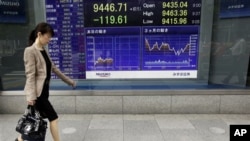Most economies in East Asia and the Pacific are doing quite well these days, with many engaged in a rather robust recovery. However, in a new update report this week from the World Bank called "Robust Recovery, Rising Risks" the bank notes that output in the region has recovered to levels that prevailed before the global financial crisis. The Update cautions though, that large capital inflows into many of these economies could lead to higher inflation and worsening asset bubbles.
In its report update, it would seem the World Bank, is lowering its outlook for growth next year. We asked the co-writer of the report, World Bank Chief Economist for the East Asia and Pacific region, Vikram Nehru, if that was the case?
"Actually we haven't lowered our outlook. What we've basically reflected in our outlook is the fact that in 2010, the rebound in East Asia from the crisis (the global financial crisis) was, in fact in some countries, growth was extremely rapid. What we're seeing now in the second half of 2010 is a gradual decline in growth as excess capacity is used up, new investments are needed. So, what we're seeing is a return to normalized growth patterns, something that is going to be much more sustainable. And that is what we're expecting in 2011, too. That is, arrival at a more sustainable growth rate in the region, so it's not actually a decline or reduction in the outlook."
China's economy has been booming and now the World Bank is predicting a slowing or at least a return to something closer to normal. If China is returning to normal, why do you think they made the move at this time to raise interest rates?
"First of all we are projecting that for this year China's growth will be at about 9.5 percent and 8.5 percent next year. That's still a pretty smart growth rate by any standards and in line with China's past performance. In recent months, in fact over the past year or so, there has been some concern in China about overheating in the economy and the real estate market and in other financial assets. Inflation is beginning to creep-up. Now, we can't be absolutely sure what was in the minds of the policy makers behind this interest rate increase, but I suspect that the main reason is to try and put a further dampener on inflation and inflationary expectations. This was an unexpected move, so clearly there is some concern with the authorities on what's happening in terms of asset prices and the asset price bubble. You know, in September, just this last month, there was an uptick in property prices in China which went against the trend of gradual decline in the stabilization of property prices. So, it's possible that this could have been the concern behind this latest move."
You say the there is a problem with capital flows, a problem in a number of countries in East Asia. Is this an indicator of what may lie ahead?
"It's very much an indicator of what's ahead. What we have seen is this huge expansion in global liquidity lapping at the shores of developing East Asian countries. We expect this increase in liquidity is going to be here to stay for some time as the advanced countries, and in particular the United States, struggles to reignite growth and to stabilize their economies. So, I think, in many of the East Asian countries we are seeing a rise in capital inflows, we're seeing appreciating exchange rates and we're seeing the emergence once again of asset price increases which are not too worrisome at this stage, but they bear very close watching. Now, provided the authorities take appropriate action as the Chinese authorities seem to have done, then I think these inflationary pressures can be contained. But, this is something we're going to have to watch very closely going forward."







